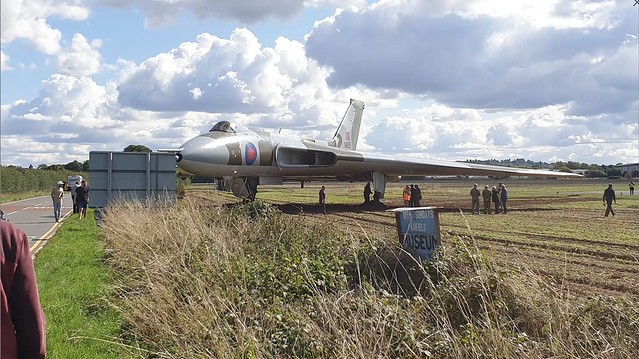Whew, that was close!
How close? This close.

Friday, during practice for a scheduled Sunday exhibition at Wellesbourne Mountford Airfield in the United Kingdom’s West Midlands region, a retired RAF Vulcan bomber overran the runway during a “taxi run,” nearly crossing the airfield boundary and onto a busy road with civilian traffic.

Here’s video of the actual incident (turn your volume down first):
#Vulcan watch until the end.
Not my filming. pic.twitter.com/R2dp7a7yOF— Husky pilot (@PilotHusky) September 16, 2022
British aviators and journalists I follow on Twitter often talk about these taxi runs, so I’m familiar with the outlines. A small number of retired military aircraft, ranging from Buccaneer and Lightning fighters to former nuclear bombers like Vulcans and Victors, while not allowed to fly, are maintained in running order by teams of volunteers, who periodically take them out for hot taxi runs. They don’t just putter about on the ramp … they take the runway for simulated takeoffs, during which they accelerate, then cut the throttles and brake to a stop (usually well before the end of the runway). The events are popular and people pay to watch. Here’s the announcement for the Sunday event the Vulcan crew was practicing for (now canceled). Here’s another announcement for a similar event involving Buccaneer fighters.
I suspect the British military services that once flew these aircraft retain ownership and impose rules on the volunteer crews that operate them on the ground. For a long time, based on YouTube videos taken from the back seat of former RAF fighters doing high-speed taxi demos, I believed that members of the public could pay to ride along, but upon looking into it for this post I’m reassured that’s not allowed — you can buy a ticket to get onto the airfield and watch these old warbirds taxi and simulate takeoff runs, but you can’t climb aboard. Whew. Because that would have been bad, last Friday.
Starting up vintage military aircraft only to taxi and simulate taking off while never leaving the ground isn’t a thing here in the States, at least that I’ve heard of.* No coitus interruptus for the Red, White, and Blue — we take off and fly, and in some cases members of the public can, for a price, ride along. Today there are somewhere around a thousand privately owned vintage military piston and jet fighters, and a handful of WWII-era piston bombers, operating in the U.S.A. The FAA imposes rules and restrictions on their operation. The aircraft have to be demilitarized, unable to employ or carry weapons. They can’t be used for personal transportation. They’re licensed as experimental/exhibition aircraft and can only be flown at air shows, to and from shows and displays, and for pilot proficiency and practice. But there are organizations that’ll sell you a seat in a retired bomber or fighter and take you up for a ride, and I don’t know how that squares with FAA rules. Money talks, I guess.
But back to the UK and Friday’s mishap at Wellesbourne. During taxi runs, the volunteer Vulcan aircrews accelerate to rotation speed and lift the nosewheel. Don’t believe me? Check out this video of an earlier (and more successful) Vulcan taxi run (ditto on the volume):
How fast is that? 150 knots (172 mph if you don’t do knots). How much of Wellesbourne’s 3,000 foot runway does a Vulcan use to accelerate to rotation speed? And how much is left to bring it to a stop?
You can call it a taxi run. You can call it a simulated takeoff. I call it an intentional high-speed abort, and any time you abort at rotation speed you’re asking for trouble. It takes only a second or two for a controllable situation to turn into an uncontrollable one. The 655 Maintenance & Preservation Society, which maintains and operates Wellesbourne’s Vulcan, claims Friday’s incident was caused by a malfunctioning airspeed indicator: “Due to a malfunction of a piece of equipment in the cockpit, the aircraft remained at full power for approximately two seconds longer than intended.”
I wonder what the mishap report’s going to say.
*I said earlier we don’t do British-style taxi runs here in the States. Actually we do, but not in public. They’re private affairs, conducted for our spouses. We did them at two of the air bases where I flew F-15s, Soesterberg AB in the Netherlands and Elmendorf AFB in Alaska, and probably did them at Kadena AB in Japan as well, but not during my assignment there. What, exactly, do we do with spouses on these taxi demos? We strap them into the back of a two-seater, hook up their intercom and oxygen, and take them out to the runway for a simulated takeoff run, during which we accelerate to rotation speed in afterburner, lift the nosewheel, then chop the throttles and brake to a stop … exactly what the Brits do on their taxi runs, but with an untrained passenger on board. Here’s a description of a recent “spouse taxi program” put on by an F-16 unit in Texas. One of these days some jock’s going to press just a little harder than normal and turn a controllable situation into an uncontrollable one, and I shudder to think what that mishap report will say.
Never turn the volume down for a Vulcan video 🙂
A lucky escape though.
I put a link to this post on Twitter and got this response from a former F-15 maintainer:
“Our spouse day rides ended early after a couple generators failed on start-up, 5 blown tires, and rumors that at least one spouse got weight-off-wheels.”
Huh. Should I be surprised?
The power was left up TWO SECONDS too long? Blimey, that seems little tight mate! ?